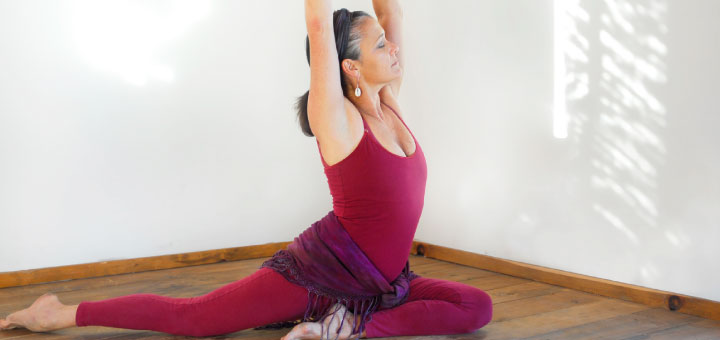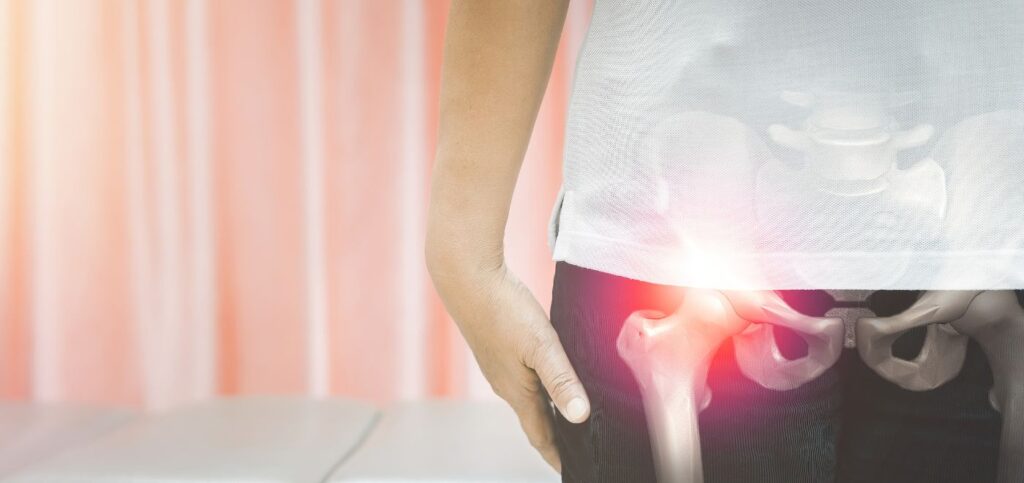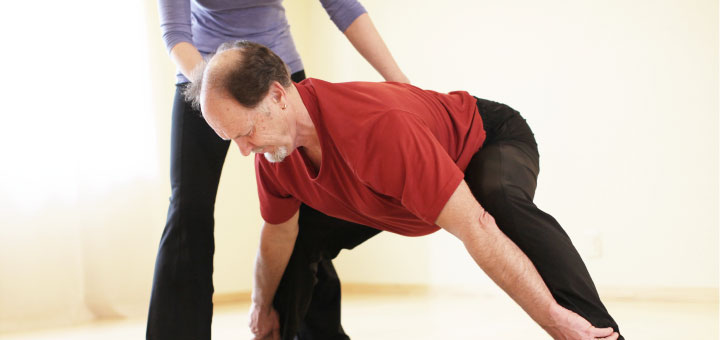Are we addicted to the Pigeon pose (and other “hip openers”)?

William Broad has done it again. Last year, he sounded an alarm about the potential risks of yoga practice, which caused some heated discussions in the yoga community. This time, he turns his attention to an issue that many yoga practitioners have a hard time understanding: Is it a problem to be too flexible?
In his latest article, Women’s Flexibility is a Liability, Broad explores the injuries that stem from being too flexible, especially when it comes to the hips: “Women’s hips showed particular vulnerability. By nature, their pelvic regions support an unusually wide range of joint play that can increase not only their proficiency in yoga but, it turned out, their health risks. The investigators found that extreme leg motions could cause the hip bones to repeatedly strike each other, leading over time to damaged cartilage, inflammation, pain, and crippling arthritis.” What are those “extreme leg motions” that he is talking about? Well, we all know that in yoga there are many. But one type that stands out to me the most is so-called “hip openers.”
Every yoga class I’ve gone to recently seems to focus on either “heart opening” or “hip opening” moves. “Heart opening,” I understand – in our sedentary, hunched-over lives, the upper backs get weak, and the chests get tight (literally and symbolically), so breathing deep and focusing on the backbends can be very useful. You still have to do it mindfully, of course.
Now, “hip opening” is a different story. When we talk about hip opening, we usually refer to external hip rotation, Pigeon pose, and the like. Many students have a love-hate relationship with this pose; it’s the kind that “hurts good.” After a few breaths there, it can facilitate a welcomed release. The question is: How important is that particular pose to the health of your hips?
The main purpose of the pigeon pose is to stretch your piriformis muscle and other external hip rotators. Doug Keller, in his article Primer on the Piriformis, gives this beautiful analogy: “The piriformis muscles are two fans of ropes that blend into a fascial hammock that hangs between the two trees [your legs]. The sacrum sits and rocks in the hammock, adjusting itself as the trees sway and move. This fascial hammock is the piriformis’s secret to regulating movement and stability in the sacroiliac (SI) joints.”
Needless to say, this is quite a delicate relationship and can be easily thrown out of balance if the piriformis gets too tight or too loose. You can end up with sciatica, SI pain, and other discomforts and imbalances. Why does the piriformis get too tight? Often from underuse (we sit A LOT and in funny positions) or overuse (for example, too much running). Why does it get too loose? It happens if sacral ligaments are hypermobile, either from birth and/or from OVERSTRETCHING. If the ligaments are too loose, it is much harder for the piriformis to stabilize the SI joints.
What do we end up with then? We get either a piriformis that’s locked in a shortened, contracted state or in a lengthened, weakened state. Either way, stretching it is the last thing you would want to do! As we’ve already covered in an earlier blog post [A smart way to relieve muscle tension], trying to stretch a locked-short muscle is like trying to pry open a clenched fist – it won’t give much and then will snap right back into place. Trying to stretch a locked-long muscle is like pulling on a leather belt; how far will that get you? It is already stretched out, and you can actually cause more damage by pulling it further.
What’s the solution, then? Contract it! The only way to produce a lasting change is to contract your rotators to make them work. Contracting the muscle increases circulation to the area, brings nourishment, and develops muscle tone and strength. You contract the piriformis by turning your leg outward against gravity. Remember that the piriformis doesn’t just rotate the hip; it also abducts the hip when it is flexed. Your hip strengthening routine needs to include the abducting moves.
Our insistence on constantly stretching the hips is a reflection of a bigger issue – too much stretching and not enough strengthening. We place much more emphasis on flexibility at the expense of stability. Yet, it is balance that we strive for. The ligaments that are too loose cannot hold the structure together, which means that somebody else has to step up to the plate, and your muscles will do it. But the primary job of your muscles is to MOVE the body, so they end up doing double duty, which is a lot of work, especially as we get older.
If we are really interested in keeping our hips healthy, extreme external rotation is not the answer. I am not saying that you should stop doing Pigeon altogether. I am saying that a balanced hip practice needs to include both strengthening and stretching poses for the full range of motion in your hip: flexion, extension, adduction, abduction, and rotation. And none of them need to be extreme. After all, for most of us, the goal is not to audition for Cirque du Soleil but to live a full life free of pain, doing things that we enjoy. Yoga practice should support us in that quest, not hinder it.

When our hips feel stiff, stretching them out seems like a good idea, but this is generally not the best course of action. Usually, your hips feel stiff or painful for one of three reasons.











Some good info here. The key is definitely balance between strength and flexibility, and that is how I teach my classes. Although secretly I’d like to be part of Cirque 🙂
🙂
Well that was an excellent read! Thank you. I’m in my 200 hour training right now and we read Broad’s article. Personally, I have very tight hips, so it’s good to learn about the relationship of the ligaments and the muscles– I needed that. One thing I do think a lot about is the correlation between hip opening and emotional release— I wonder if that fuels the emphasis on these postures. I have some friends who have had really transformative experiences in pigeon. Looking forward to more of these articles!
Thank you Jacki! I completely agree with the emotional release idea. Theoretically the emotional release is connected to the concentration of energy and attention in the sacral area (the location of the second chakra); hip work is just one way to get access to it. If someone is getting a lot out of pigeon – great! As long as they prepare and compensate adequately.
Awesome post, Olga. Thank you! 🙂
Thank you Terra!
Oh, how I love a good conversation like this! I am obsessed with SIJ stability, having injured mine as a young and naive yogi years ago. And I agree. Stability. Get the muscles to the correct length so they can contract to generate force, then contract them so they get stronger.
I spend a lot of time on lateral hip strength, for myself and with my students.
Just a quick question: I can’t seem to open the link to the balance hip strength practice. It says page not found. Help?
Thank you for your comment Nadine!I am a “strength junkie” myself, as you have probably noticed 🙂 Sorry about the link, should be working now!
Another great article Olga! When I click on the link to the Hip Strengthening Practice video, I am taken to your home page rather than that specific video.
Well it looks like you wrote this article exactly a year ago from when I did pigeon pose and now my entire leg hurts and I feel like I have sciatica and now we’re as before it was fine and I guess I over stretched it. When I was in pigeon pose on my right leg I started to feel a little bit of a numbing sensation. & I think it was because she made a thread the needle by bringing are left arm under are right armpit and bring your right behind our back. I’ve never done this twisting post before and I am of yoga instructor so I think that she may have made something up or gotten this from another flow as I teach vinyasa and this may be an ashtange pose. Either way I’ve never had a problem with over stretching until now I am 20 years old and I am shocked with how badly my knee was hurting all night and it was a nerve pain that stems from my hip to my foot.
You may also want to be more cautious or even reconsider doing Pigeon pose if you have underlying Femoral antiversion of your hips. Folks that have this can usually W sit but have a difficult time Taylor sitting. The femoral head is aligned differently than a normal or a retroverted hip which would make you exceed what is considered normal for the structure of an antiverted hip. You could potential tear the labrum or cartilage of the hip joint and cause hip impingement.
you are amazing. do you have any thoughts on pre natal and hips?
HI Olga, the article in the NY times on how women’s’ hip are a liability in yoga is still getting a lot of attention. I am Michaelle Edwards, the posture educator yoga teacher who is mentioned in the article. I did search for months to find a way to contact and alert William Broad to the hip issues caused by over-stretching the hip stabilizers. He posted my article When Flexibility Becomes a Liability in that article and was surprised when he interviewed orthopedic surgeons who confirmed that a majority of the clients were yoga practitioners. Since 2013, more teachers are getting hips like Jill Miller who at age 45 needed double hip replacements and even Larry Payne, who started the International Yoga association of yoga therapists has had knee and hip replacements. My question is this. If yoga is therapeutic, why are so many yogis getting joint replacements? Some say well yoga did not cause the joint deteriorations but my answer would be yoga also did not prevent it. I think that we should be teaching yoga and movement in a way that seeks to stabilize rather than stretch our joints and serve as a warranty for lifelong joint health. No doubt the glamorization of flexibility in the yoga industry is partly responsible for people over-stretching and doing yoga as a performance art or sport. I appreciate that we come from the same perspective that when muscles feel tight, they are probably weak and short or long and tight and pulling on them by stretching makes no anatomical sense at all. I continue to work with hundreds of yogis who have not only destabilized their hip joint ligaments but also the entire spine has lost the natural curves as well as the knees and feet. It is as though people are pulling themselves apart at the seams to perform yoga poses many of which go against how the joints are designed to articulate and work like loaded springs. Please share the yoga injury survey I am conducting to help us all understand how the epidemic of yoga injuries is happening. https://yogalign.com/yoga-injury-survey/